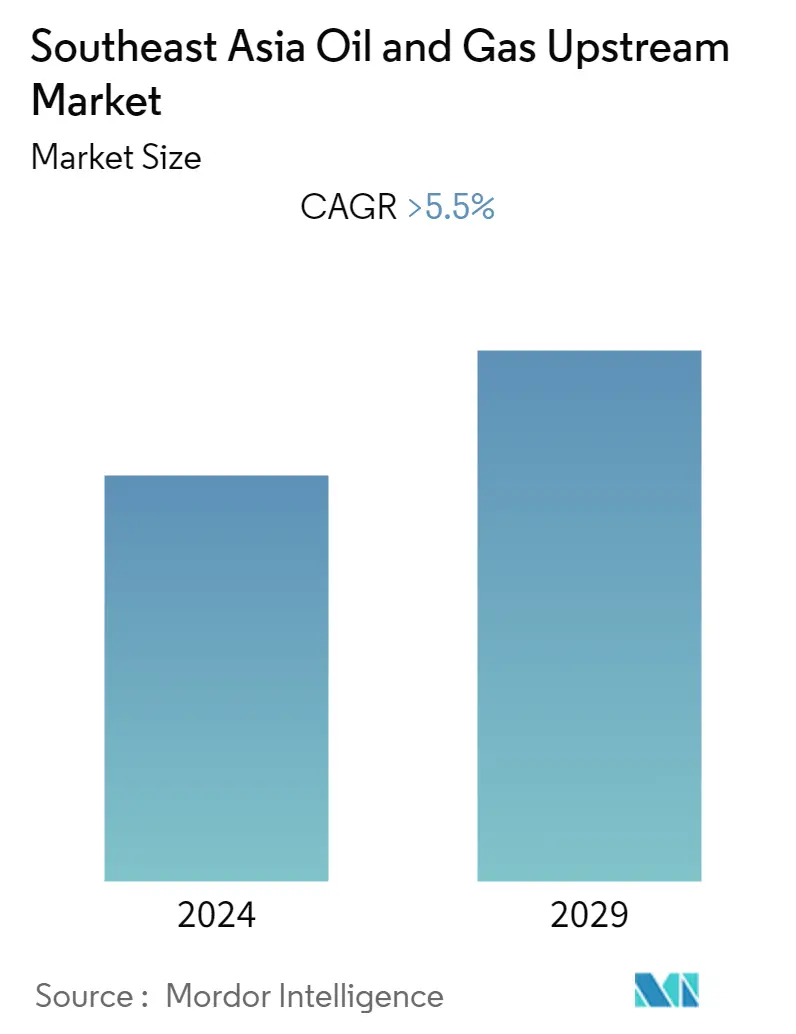Market Size of Southeast Asia Oil and Gas Upstream Industry

| Study Period | 2020 - 2029 |
| Base Year For Estimation | 2023 |
| Forecast Data Period | 2024 - 2029 |
| Historical Data Period | 2020 - 2022 |
| CAGR | 5.50 % |
| Market Concentration | Medium |
Major Players.webp)
*Disclaimer: Major Players sorted in no particular order |
Southeast Asia Oil and Gas Upstream Market Analysis
The Southeast Asian oil and gas upstream market is expected to register a CAGR of more than 5.5% during the forecast period, 2022-2027. The outbreak of the COVID-19 had negatively impacted the market as lockdown restrictions imposed by the governments in the region have reduced the petroleum products consumption in the region. During the COVID-19 in Q1 of 2020, the region's oil and gas demand dropped by 520,000 barrels per day (b/d). Also, the COVID-19 has caused the delay in the various projects across the region. For instance, Indonesia postponed its six oil and gas bidding rounds, and Petronas delayed its Kelidang cluster in Brunei and Malaysia. Factors such as increasing demand for oil and natural gas and rising foreign direct investment are expected to boost the Southeast Asian oil and gas upstream market during the forecast period. However, with the advent of reliable and cheaper renewable energy, more investment may not focus on oil and gas.
- The offshore sub-segment is expected to dominate the market during the forecast period.
- Countries in the region are eagerly finding and trying to produce oil and natural gas reserves. As a result, increased exploration and discoveries are being made, which could become an opportunity for many players and new entrants in the market.
- Malaysia is expected to dominate the market during the forecast period, owing to new investments in the upstream oil and gas industry.
Southeast Asia Oil and Gas Upstream Industry Segmentation
The Southeast Asian oil and gas upstream market report includes:
| Location | |
| Onshore | |
| Offshore |
| Geography | |
| Thailand | |
| Singapore | |
| Indonesia | |
| Brunei | |
| Malaysia | |
| Vietnam | |
| Rest of Southeast Asia |
Southeast Asia Oil and Gas Upstream Market Size Summary
The Southeast Asian oil and gas upstream market is poised for growth, driven by increasing demand for oil and natural gas and rising foreign direct investment. Despite the initial setbacks caused by the COVID-19 pandemic, which led to reduced consumption and project delays, the market is expected to recover and expand. The offshore sub-segment is anticipated to lead the market, with countries in the region actively exploring and producing oil and gas reserves. Malaysia is projected to be a key player, benefiting from new investments in its upstream oil and gas industry. The region's strategic focus on enhancing hydrocarbon production through exploration and investment is expected to bolster its position as a vital global oil and gas producer.
The market landscape is moderately consolidated, with major companies such as Total Energies SE, Shell PLC, Exxon Mobil Corporation, and Petroliam Nasional Berhad playing significant roles. Malaysia's oil and gas sector, a crucial contributor to the country's GDP, is set to witness growth through upcoming projects and investment flows. Notable developments include the Pegaga gas project and the Kasawari gas field, which are expected to enhance production capabilities. Additionally, international exploration activities, such as those by Pharos in Vietnam, highlight the region's potential for significant discoveries. As deep-water projects gain importance, the Southeast Asian market is well-positioned to meet the increasing demand for oil and gas, supported by strategic investments and exploration initiatives.
Southeast Asia Oil and Gas Upstream Market Size - Table of Contents
-
1. MARKET OVERVIEW
-
1.1 Introduction
-
1.2 Market Size and Demand in USD billion, till 2027
-
1.3 Recent Trends and Developments
-
1.4 Government Policies and Regulations
-
1.5 Market Dynamics
-
1.5.1 Drivers
-
1.5.2 Restraints
-
-
1.6 Supply Chain Analysis
-
1.7 Porter's Five Forces Analysis
-
1.7.1 Bargaining Power of Suppliers
-
1.7.2 Bargaining Power of Consumers
-
1.7.3 Threat of New Entrants
-
1.7.4 Threat of Substitute Products and Services
-
1.7.5 Intensity of Competitive Rivalry
-
-
-
2. MARKET SEGMENTATION
-
2.1 Location
-
2.1.1 Onshore
-
2.1.2 Offshore
-
-
2.2 Geography
-
2.2.1 Thailand
-
2.2.2 Singapore
-
2.2.3 Indonesia
-
2.2.4 Brunei
-
2.2.5 Malaysia
-
2.2.6 Vietnam
-
2.2.7 Rest of Southeast Asia
-
-
Southeast Asia Oil and Gas Upstream Market Size FAQs
What is the current Southeast Asia Oil and Gas Upstream Market size?
The Southeast Asia Oil and Gas Upstream Market is projected to register a CAGR of greater than 5.5% during the forecast period (2024-2029)
Who are the key players in Southeast Asia Oil and Gas Upstream Market?
Petroliam Nasional Berhad (PETRONAS), Petroleum Authority of Thailand (PTT), Exxon mobil Corporation, Shell Plc, Total Energies SE and Exxon Mobil Corporation are the major companies operating in the Southeast Asia Oil and Gas Upstream Market.

